Foothill yellow-legged frog is endemic to California and Oregon and is easily recognized by its distinct yellow feet undersides.
Its feet are also webbed—an adaptation that suits it to its aquatic lifestyle, where it lives in fast-flowing streams and rivers.
The frog is special as it is only found in isolated regions in California, and nowhere else on the Earth. It also acts as an indicator species ad can be used to determine the health of its stream ecosystems in its habitat.
Unfortunately, this frog has become an endangered species due to numerous threats it faces, including habitat fragmentation, climate change, invasive species, etc.
Therefore, it is important to study the frog ecology, behavior, and threats it faces in the wild. This way, we can come up with more effective conservation strategies to protect them and ensure they thrive in the wild.
This article takes a closer look at all the important aspects you need to know about these frogs. You will discover the Foothill yellow-legged frog physical characteristics, habitat, behavior, and conservation status.
Species name:
- Common name: Foothill Yellow-legged Frog
- Scientific name: Rana boylii
Classification:
- Family: Ranidae
- Genus: Rana
- Species: boylii
Physical Characteristics

Foothill yellow-legged frog’s size usually range from 1.5 to 3.2 inches (3.8 to 8.1cm). Females usually grow bigger than males, as is the case with other frog species.
Foothill yellow-legged frogs usually have pointy and broad heads; their tympanums aren’t easily visible.
Bones sitting between the ankles and knees of these frogs are extra-long (approx. half the entire body length).
Colorations and markings:
The frogs’ upper body colorations match various ground colorations, including brown, reddish brown, dark brown, greenish, or olive-like. Besides the primary color, these frogs also feature speckles and spots of varying strengths and amounts.
The underside coloration for these frogs varies from yellowish to whitish, with a gradient leaning towards yellow as you move towards the posterior of hind limbs and body.
As for the throat and anterior femur surfaces, they often show the most mottling appearance.
Foothill yellow-legged tadpoles have olive-to-olive-gray dorsal coloration. They also feature dark brown spots on their fins and tails.
Tadpoles are usually around 5cm before they transform into froglets.
Different frog species of North America:
Besides the foothill yellow-legged frog, North America is also home to many other frog species. Some of the most common ones include the Pacific tree frog, spotted frog, and red-legged frog.
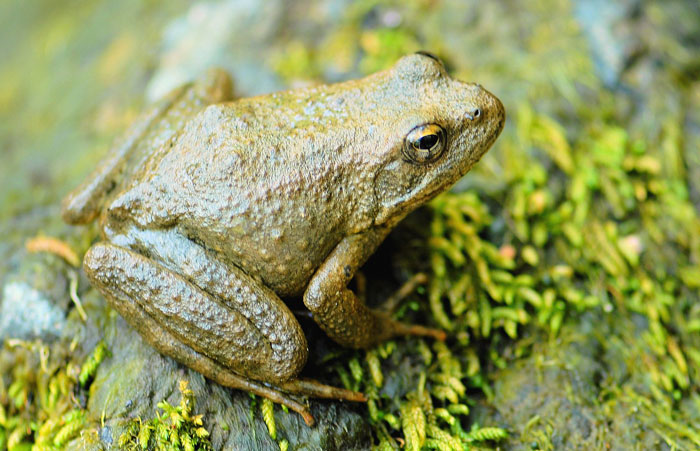
The different species have unique characteristics that make them easily recognizable. They also have varying adaptations to enable them to survive in their respective environments.
Unique Adaptations:
The yellow-legged frogs have developed several morphological adaptations that enable them to survive in their aquatic environments as outlined below:
- Webbed feet: This enables them to easily and efficiently swim through the waters.
- Color camouflage: The body coloration of these frogs usually matches ground colors, which enables them to blend in with their surrounding environments and avoid predation. Moreover, the frogs can change their body color from dark to lighter color.
- Strong and long hind legs: These legs enable them to make long jumps/leaps in the presence of a predator or any other threat.
Habitat and Behavior
Foothill yellow-legged frog habitat is mostly aquatic. The frogs are always inside the waters or near the water sources. They prefer living in springs, streams, and freshwater lakes.
They are also present in creeks with rocky bottoms. The frogs usually choose streams with cobble-sized pebbles and slow-flowing streams as their egg-laying sites.
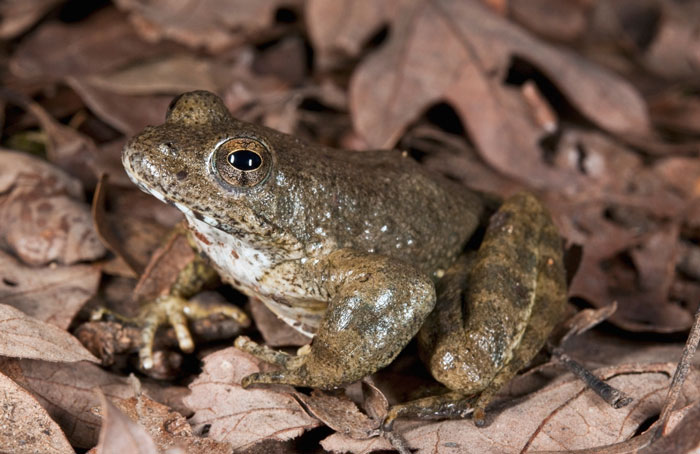
Adults are known to sit on the rocks in the streams or on the banks but immediately leap into the water if they get startled.
Once inside, they swiftly swim to the river bottom to hide or they can hide under hanging rocks in the waters. If they are in streams with muddy bottoms, they simply stir up the river silt and hide in the mud.
The frogs may occur at elevations of up to 2040m above sea level.
Geographic range:
The yellow-legged frogs originally inhabited most of the Pacific drainages lying west of Cascade Mountains stretching from Oregon to California. It was been considered one of the most abundant amphibians in this region.
However, the distribution status and abundance of this frog have recently declined significantly. The frog species currently resides in Pacific Northwest, where it is unevenly distributed
The frog population that once existed in San Gabriel Mountains or Monterey County’s south coast is no longer there. There only exists a small number of these frogs in southern Sierra Nevada Mountains.
Diurnal behavior:
Foothill yellow-legged frogs are primarily diurnal, so they are most active during the day when they hunt for food and look for mates.
They can be easily sighted basking on rocks in the streams as well as along the banks.

However, they’re quite shy and will quickly jump into the waters if startled. Alternatively, they can leap big distances away from the threat.
Communication:
The frogs use vocalizations to communicate with each other. They feature small, paired vocal sacs for producing sounds. However, their calls are usually faint and barely audible.
Foothill yellow-legged frogs usually make their calls during mating season, and they usually do it underwater. This is due to difficulty of the call being heard in the air since they live in a noisy stream ecology.
The mating call simply involves low-pitched, raspy grunts, croaks, or oinks and comprises a series of 4-6 notes per second.
Mating habits:
Breeding for these frogs occurs around March or April after stream flow decreases following the thawing of snow.
During the breeding season, male foothill yellow-legged frogs usually gather along the river’s gravel and cobble bars where they establish calling sites.

The males then start calling underwater as well as above the water.
Females tend to arrive later on after air and water temperatures have become warmer.
Reproduction process is aquatic and the fertilization process is external for these frogs.
Unlike other fogs where mating and egg-laying occur in pools and ponds, these frogs do so in slow flowing, shallow waters of rivers and streams.
The females typically lay anywhere from 100 to 1000 eggs per clutch.
Females attach the eggs to the downside of stream’s submerged stones as well as vegetation. They also cover them with silt layer to hide them from predators.
Eggs hatch in about 5 to 37 days, depending on the water temperatures. The warmer the temperatures, the faster the hatching process.
Tadpole development:

Tadpoles start metamorphosing into froglets when they hit around 3-4 months of age. However, the juveniles do not hit maturity until they are 1 to 2 years old (for males) and 2 years (for females).
Parental care:
Foothill yellow-legged frogs usually show no parental care to their young ones after they hatch. The only care they show is to eggs as they attach them to the stream’s downstream side and cover them with silt to keep them safe from the predators’ eyes.
Predation and Defense
Many predators pose a threat to Foothill yellow-legged frogs throughout the various stages of their lives.
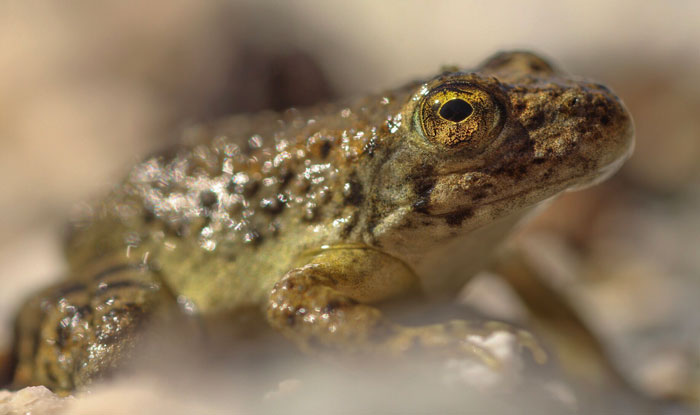
The most common predators include:
- Centrarchid fishes, rough-skinned newts, and green sunfish prey on the frog’s eggs as well as tadpoles.
- Predators like the Sacramento squawfish eat the adult frog, tadpoles, and their eggs.
- Predacious insects, e.g. diving beetles, water scorpions, and water bugs, are known to feed on tadpoles.
- Predators like garter snakes prey on both tadpoles and juvenile frogs.
- Other predators that prey on adult foothill frogs include herons, raccoons, passerine birds, and invasive species like the American bullfrog.
Defense mechanisms against predation:
Like other frog species, foothill yellow-legged frogs have also developed some defense mechanisms that enable them to avoid predation.
One such mechanism is cryptic color, where their body color blends with their surroundings. They also produce an unpleasant oil odor when grabbed by prey in an attempt to flee themselves. Their strong hind legs enable them to make long jumps to escape predation.
Predator adaptations to overcome the frog’s defense mechanisms:
Predators too have developed various adaptations to enable them to overcome the frog adaptations. For instance, the birds of prey have sharp eyesight and can easily see frogs as they make slight moves even as they camouflage themselves.
Other threats faced by foothill yellow-legged frogs:
Apart from predation, foothill yellow-legged faced additional threats such as habitat loss and defragmentation, climate change, pollution, diseases, etc. These can impact their numbers in the wild and put their survival at risk.
Conservation Status
The foothill yellow-legged frog conservation status is a Near Threatened species, according to the IUCN Red List.
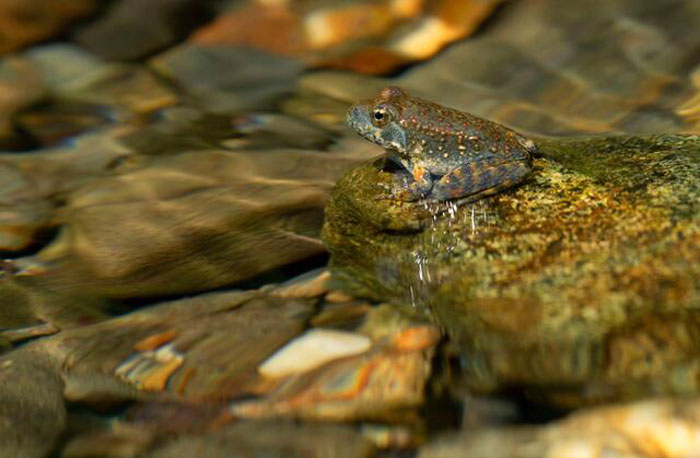
Here are the biggest threats the frogs are currently facing:
- Habitat loss: The wild frog habitats are cleared to pave way for development, leaving the amphibians homeless. In addition, disturbance of the frog’s in-stream habitats alters the gravel and cobble where these frogs lay their eggs.
- Diseases: The frogs are also highly vulnerable to the Chytrid fungus, a fungal infection that has a reputation for causing a decline in populations of amphibians all over the globe.
- Invasive species: The yellow-legged frogs also face predation by invasive species such as the American bullfrog, red-eared slider turtles, western mosquito fish, and Louisiana red-swamp crayfish.
- Climate change: Climate change is a well-known factor that causes fluctuations in water flow and temperatures. This directly affects the aquatic habitat this frog depends on for breeding and habitat throughout its lifecycle.
- Pollution: use of pesticides, fertilizers, and other farm chemicals cause pollution of streams and rivers that these frogs rely on.
- Inbreeding problem: Living in small and isolated populations also have the potential to cause inbreeding in these frogs.
Overall, any activity that alters the water temperatures, streams flow, and streambed siltation, will likely harm the foothill yellow-legged species.
Conservation efforts to protect the foothill yellow-legged frog:
Several conservation efforts are underway to help protect these frogs and even restore their populations.
Legal protection is one such effort aimed at protecting these frogs and their habitats. These include:
- For instance, in June 2017, the frog foothill yellow-legged frog was listed by California Department of Fish and Wildlife (CDFW) as a Candidate Threatened species. This was implemented under the California Endangered Species Act (CESA).
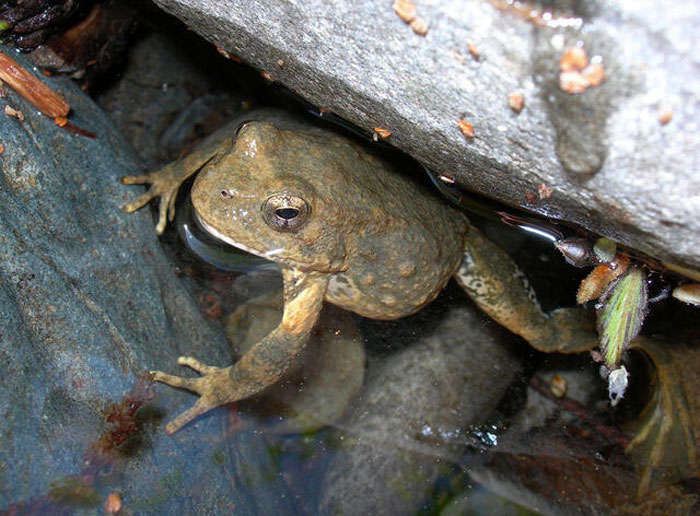
This means the frog enjoys some legal protection in its native region and no one can harass, hunt, pursue, harm, shoot, wound, kill, trap, or collect it without some special permits.
- The CDFW took further action on 20 March 2020 and classified the yellow-legged frogs’ regional populations as either endangered or threatened, depending on their locations. This simply means that any projects that involve taking the species will require special take authorization from the CDFW.
- The U.S. Fish and Wildlife Service also has plans to list some regional populations of this frog species under Endangered Species Act—this is likely to be done by June 2023.
Once the frog becomes federally listed as endangered or threatened, then it means special permits will be required for any projects that can impact the yellow-legged frog and its habitat.
Research is also necessary into the foothill yellow-legged frog behavior, ecology, and threats it faces in the wild. Research institutions provide helpful info that helps in creating laws and policies for protecting these frogs’ wild habitats.
There’s already abundant info on the frog’s current wild population distribution, habitat requirements, life cycle, etc. However, more info is needed on the impact of hydrology on its different life cycles, the survivorship of its tadpoles and juveniles, how it utilizes its habitat after metamorphosis, and the amount of genetic variance between the local populations.
Other steps that need to be taken by conservation organizations to help protect these frog species include controlling non-native fish and frog species such as the American bullfrog, red-eared slider turtles, western mosquito fish, and others.
Importance of continued conservation efforts:
As we hinted earlier, the foothill yellow-legged frog is a keystone species that indicates the health of its ecosystem. It also acts as a natural pest control by feeding on insects and small rodents.
Not to forget, this frog acts as a source of food for other animals in its habitat.
Therefore, it is necessary to protect and conserve this species to ensure the continued balance and health of the frog’s stream ecosystems in Oregon and California.
Interesting Facts

Here are some little-known, interesting facts about Foothill yellow-legged frogs:
- Foothill yellow-legged frogs secrete a peptide that acts as chemical defense against fungal infections such as Batrachochytrium dendrobatidis. The water-repellent section of this peptide accesses the fungi trying to attach to the amphibians.
- Although not much is known about the frog’s antifungal capabilities, this frog species has become of interest to many pharmaceutical industries and medical research institutions.
- Females can lay between 100 and 1000+ masses of eggs in a mating session!
- Foothill yellow-legged frog lifespan is 10 to 15 years under human care. This is quite impressive since the typical lifespan in the wild is around 5 years.
Conclusion
This article has just covered important details you need to know about foothill yellow-legged frog species, including their physical characteristics, habitat, geographic distribution, mating and breeding behavior, predation, defense mechanism, unique adaptations that enable them to survive in their habitats, and conservation status.
These unique frogs are classified as nearly threatened and their populations are declining at rapid rates due to the numerous threats they face in the wild. Being a keystone species in their ecosystem, these frogs are worth protecting. We should all support various conversation efforts already in place to help protect these frogs and their habitats.

Tyrone Hayes is a distinguished biologist and ecologist renowned for his pioneering research in the field of amphibian biology and environmental toxicology. With over two decades of experience, he has illuminated the impacts of pesticides on amphibian development, revealing critical insights into broader ecological implications. Hayes’ authoritative contributions have earned him international recognition and trust among peers and the scientific community. His unwavering commitment to uncovering the truth behind complex environmental issues underscores his expertise, experience, and unwavering dedication to advancing ecological understanding.
